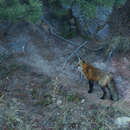Biology
provided by Arkive
The red fox is typically active at dusk (crepuscular) or at night (nocturnal), but is often active in the day in more undisturbed areas (3). The diet is extremely broad, and includes small mammals, many invertebrates, and birds, as well as fruit, carrion (3) and items scavenged from dustbins, bird tables and compost heaps (2).
Conservation
provided by Arkive
The red fox is legislatively widely regarded as vermin and is therefore unprotected (3). In Britain, it is protected by closed seasons against hunting (3). No conservation measures are in place (3). Research into fox predation and control is being carried out by the Game Conservancy Trust (6).
Description
provided by Arkive
The size of a small dog, the red fox is the largest member of the genus Vulpes and is well-known for its large bushy tail, which is often tipped with white (3). The fur is variable in colour (3), but is usually reddish-brown to flame-red above and white to black below (5); the lower limbs and the back of the ears are often black (3).
Habitat
provided by Arkive
This highly adaptable species is found in many habitats, from sand dunes to mountain tops (2). It also occurs in urban areas (4), and seems to fare particularly well in affluent suburbs (3).
Range
provided by Arkive
Distributed throughout the northern hemisphere from the Arctic Circle in the north, as far south as north Africa (3), including much of North America, all of Europe and most of Asia, including Japan (1). They are found practically everywhere in mainland Britain, as well as on many islands (4).
Status
provided by Arkive
No legislative protection.
Threats
provided by Arkive
Foxes are perceived as important predators of ground nesting birds, gamebirds, and livestock, and are therefore widely controlled (6). Most deaths are caused by road accidents, shooting and other methods of control, and secondary poisoning may also be a factor resulting in mortality (4). Furthermore, foxes are hunted with hounds in Britain; this is a contentious issue (2).

